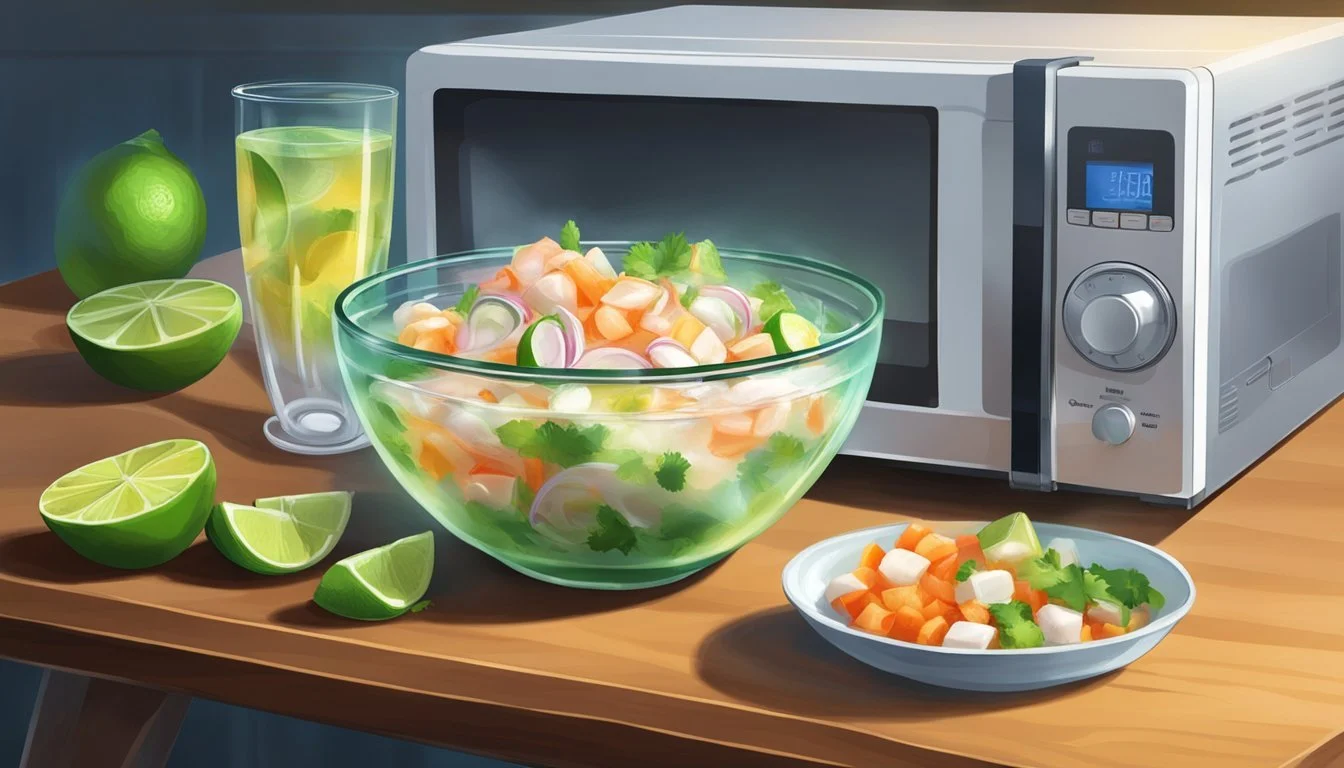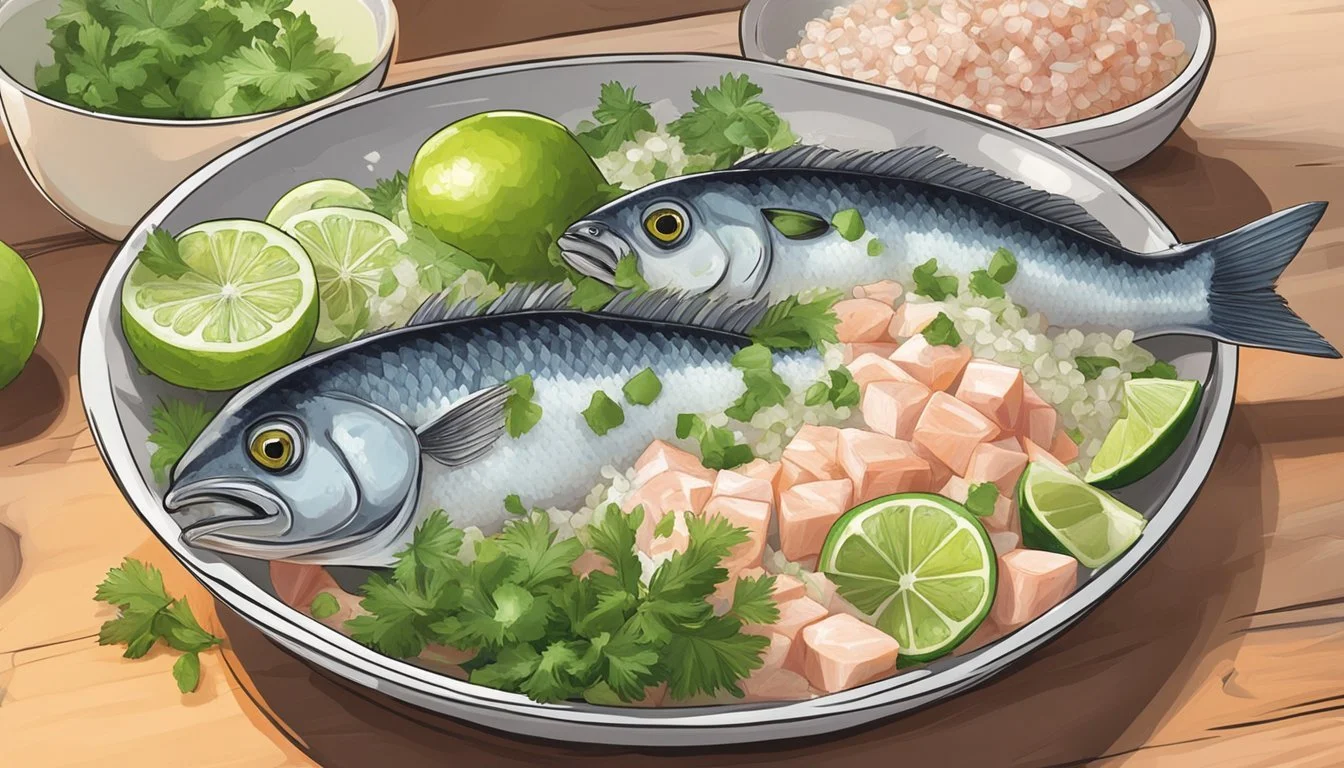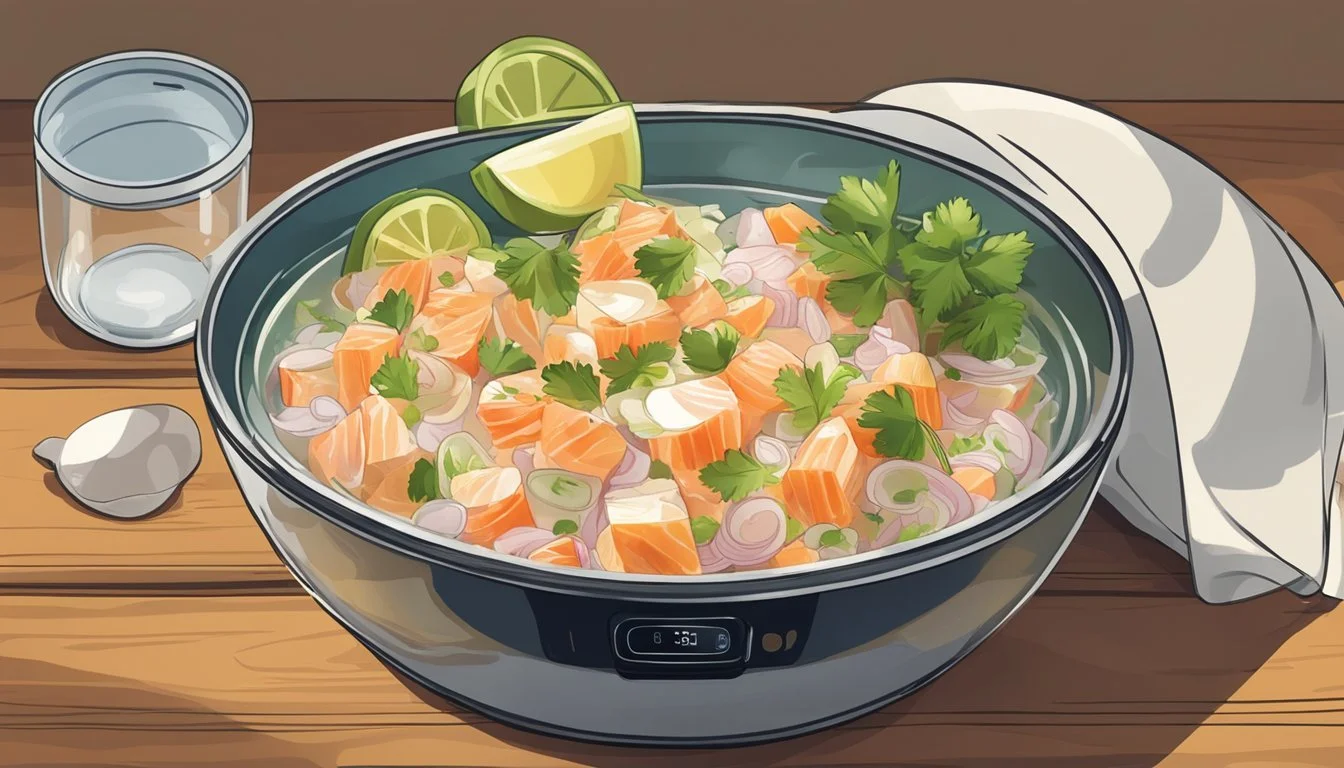Best Way to Reheat Ceviche
Ensuring Freshness and Texture Retention
Ceviche represents the quintessence of coastal cuisine, bringing together the vibrant flavors of fresh fish, tangy citrus, and aromatic herbs. Unlike traditional cooking methods that rely on heat, the preparation of ceviche utilizes the acidity of lemon or lime juice to change the protein structure of raw fish, effectively "cooking" it without the application of thermal heat. This unique process, while straightforward, leaves little room for error when it comes to reheating, as the primary allure of ceviche is its freshness and the delicate balance of flavors and textures.
Serving ceviche at its optimal state requires an understanding of its components and the chemistry that defines its texture. Because ceviche is not cooked with heat, the term 'reheat' may seem misleading, as the objective is to restore the dish to its ideal chilled serving temperature rather than to re-cook it. Reheating in this context seeks to revive the refreshing coldness that complements the dish's acidity, without compromising the fish's tender structure or the vibrant zest of its marinade.
Professionals and culinary enthusiasts agree that the best way to enjoy ceviche is to consume it shortly after preparation. However, under certain circumstances where refrigeration has altered the coldness of the dish, a careful approach to restoring its temperature is crucial. The aim is not only to maintain the integrity of ceviche's texture but also to ensure that the harmony of its flavors remains as close to the original preparation as possible.
Understanding Ceviche
Ceviche is a classic dish with a vibrant fusion of flavors and textures, heavily reliant on the freshness and quality of its seafood (What wine goes well with seafood?) and accompaniments.
History and Origin
Ceviche, predominantly associated with Latin America, has its roots deeply embedded in the coastal regions of Peru. The method of marinating seafood in citrus juices, such as lime or lemon, dates back to the ancient Inca civilizations and has been adapted through the centuries especially by countries like Ecuador and Mexico.
Ceviche Ingredients
A traditional ceviche blend includes seafood such as sea bass, halibut, flounder, scallops (What wine goes well with scallops?), or shrimp. Accompanying these proteins are fresh ingredients like onion, citrus juice (often lime juice), cilantro, chili peppers, corn, tomatoes, cucumber, and garlic. Avocado is sometimes added for its creamy texture.
Ceviche Nutrition
Ceviche is heralded as a healthy dish with high protein content and low in fat. Nutrients vary based on ingredients, but a serving is generally low in calories while offering vitamins and minerals from both the seafood and abundance of vegetables.
Cultural Variations
While Peruvian ceviche is the most widely recognized, variations exist across different regions. Ecuadorian ceviche often includes tomatoes and corn as staples, while in Mexico, the dish might be spicier with added chili peppers and served with tostadas or corn chips.
Freshness and Flavor
The essence of ceviche lies in its freshness. The use of straight-from-the-ocean seafood and ripe produce is key to achieving the intended flavor profile. Citrus juice not only imparts a zesty taste but also performs the essential role of "cooking" the seafood through acid.
Texture Considerations
Marinating the seafood for the right amount of time is critical for optimal texture. Ideally, fish should be firm but not tough. Over-marinating can make proteins too soft and ruin the desired mouthfeel.
Food Safety
When preparing ceviche, food safety is paramount. Using fresh, high-quality seafood minimizes risks of bacteria and parasites. Acid from the citrus juice aids in reducing microbial risks but is not a substitute for proper handling and refrigeration to ensure safety and freshness.
Preparing Ceviche at Home
Creating ceviche at home involves a careful selection of fresh ingredients and precise techniques to ensure a dish that bursts with vibrant flavors and maintains an ideal texture.
Selecting Ingredients
Protein: Opt for fresh, lean seafood like red snapper or tuna when preparing ceviche. The freshness of the fish is paramount, as it will be consumed raw.
Vegetables: Pair the seafood with a combination of onions, preferably red, cilantro, jalapeño for a kick, and avocado for creaminess. These should all be fresh to complement the fish.
Ceviche Marination
Marinade: The citrus juices, predominantly lime juice, are not just for flavor—they "cook" the raw seafood with their acid. The marination time should be carefully watched; usually, a period of 15 to 25 minutes is enough.
Cutting Techniques
Using a sharp knife and a sturdy cutting board, cut the fish into uniform, bite-sized pieces to ensure even marination. Similarly, veggies like onions and jalapeño should be thinly sliced for a harmonious mix.
Mixing and Marinating
In a mixing bowl, gently toss the protein with the citrus juice and onion to start the marination. The use of oil, herbs, and spices can be adjusted based on preference, but simplicity often yields the best results.
Flavor Enhancements
Enhance flavors with additional sea salt or seasonings. A splash of olive oil can bring richness, while small amounts of herbs and spices can offer subtle complexity to the dish.
Serving Suggestions
Serve ceviche chilled, usually as an appetizer with tortilla chips or plantain chips. Fresh toppings such as cilantro, red onion, and avocado should be added just before serving to maintain their texture and flavor.
Storing Ceviche
Refrigerate leftover ceviche in an airtight container to minimize exposure to air. Ideally, consume it within 24 hours by keeping it in the coolest part of the fridge for optimal freshness.
Ceviche and Dietary Preferences
Ceviche is inherently gluten-free and suits pescetarian diets. However, for those with shellfish allergies, ensure no cross-contamination occurs. For a vegan version, substitute seafood with vegetables like avocado and marinate in the same citrusy mix.
Best Reheating Practices for Ceviche
Ceviche's unique preparation centers around the delicacy of its flavors and textures, making reheating a matter that requires finesse and understanding of its components such as the proteins and acid balance.
Reheating Fundamentals
When reheating ceviche, it is crucial to remember that it isn't cooked using heat but is rather "cooked" by the acidity of the marinade. Thus, traditional reheating methods are not applicable. Instead, one should focus on gently bringing the dish to a palatable temperature without actually subjecting it to direct heat.
Maintaining Freshness While Reheating
To maintain the optimal freshness and flavor of ceviche, it is best removed from the refrigerator and allowed to reach a slightly cool or room temperature naturally. Ceviche is best enjoyed when the freshness of the seafood is at the forefront, which can be overshadowed by the chilliness if served too cold.
Avoiding Overcooking
Since the proteins in the seafood have been denatured by the acidity from the citrus juice, additional heat can cause them to become tough and rubbery. It's not advisable to use ovens, microwaves, or stovetops for reheating, as these might "overcook" the delicate proteins.
Choosing the Right Reheating Method
If the ceviche is too cold directly from the refrigerator, placing it in a sealed container within a larger bowl of lukewarm water can bring the temperature up without introducing direct heat. This method helps distribute a mild heat evenly and avoids cooking the seafood further.
Safety Measures During Reheating
Food safety should not be overlooked when handling ceviche. Given its raw nature and the potential risk of bacteria, ceviche should always be stored properly in the refrigerator when not being served. Ceviche should not be left out at room temperature for extended periods to prevent bacterial growth.
Creative Ways to Repurpose Ceviche
Ceviche, traditionally enjoyed fresh, need not go to waste. Here are inventive approaches to give leftover ceviche new life, from appetizers to mains, ensuring flavors and textures remain vibrant.
Incorporating Leftovers into New Dishes
Leftover ceviche can transform into the star ingredient in several dishes. Example: Mix it into a warm seafood pasta where the citric acid of the ceviche's marinade enhances the overall flavor of the sauce.
Ceviche-Inspired Recipes
Creativity in the kitchen leads to innovative ceviche-inspired recipes. Think of converting it into a filling for empanadas or adding it to a summer gazpacho for a refreshing twist, thereby leveraging its seasoned protein content.
Salads and Appetizers
Mix ceviche with greens to serve as a light and healthy salad. Use bold condiments like an avocado or citrus dressing to balance the dish. Alternatively, spoon it onto crackers for easy-to-serve appetizers that offer a burst of flavor and protein with negligible additional calories.
Hot Ceviche Creations
Heating ceviche can alter its delicate texture, yet gentle warming on a stovetop can turn it into a filling for tacos or quesadillas. Use a non-stick skillet and a low flame to maintain the integrity of the fish while melding it with melted cheese and tortillas.
Pairings with Ceviche Flavors
The nuanced flavors of ceviche make it ideal for beverage pairings. For wine pairing, a crisp Sauvignon Blanc complements the dish’s acidity. Beer pairing is equally delightful, with a light lager offering a refreshing counterbalance. Always serve as an accompaniment that respects the ceviche's seasoning and zest.
Through this approach, one can maintain the essence of ceviche while exploring new culinary territories, hence combining health, flavor, and innovation on a plate.
Conclusion
When reheating ceviche, the goal is to preserve its fresh flavors and delicate textures. It is crucial to remember that traditional ceviche isn't heated, as it's "cooked" through marination in citrus juices. However, if one must warm up leftover ceviche, they ought to do so gently and carefully to avoid "overcooking" the seafood and altering its intended experience.
One should preferably consume ceviche fresh, but if necessary, they can gently bring it to room temperature by placing it out of the refrigerator for a short while. It's essential to avoid direct heat or microwave use as these methods can cook the fish further and damage its texture.
Note: Reheating ceviche is not a standard practice and can potentially diminish its quality. Cold ceviche is enjoyable, and its cool temperature is part of its refreshing appeal. They should always heed food safety guidelines and enjoy ceviche within a couple of days after preparation.
In summary, ceviche lovers are advised to enjoy this dish fresh. If leftovers exist, they should cautiously allow it to reach room temperature to slightly take off the chill without compromising its quality. The exquisite balance of fresh fish, tangy citrus, and accompanying seasonings are best appreciated when the dish is served as originally intended—chilled and vibrant.
Glossary of Terms
In this section, crucial terminology related to the preparation and preservation of ceviche is discussed. Understanding these terms is essential in grasping the best practices for reheating ceviche to maintain its fresh flavor and texture.
Key Ceviche Terminology
Acid: Refers to the citrus juice used in ceviche that "cooks" the raw fish through chemical means without heat. The acid typically comes from lemons or limes and is critical for the marinating process, preserving flavor and texture.
Texture: The perceived feel of food in the mouth. In ceviche, texture is greatly affected by the marinating time in acid. Excessive marinating can cause the fish to become overly soft or mushy.
Flavor: The combination of taste and aroma. The flavor of ceviche should be fresh and tangy, prominently featuring the citrus notes from the acid used for marinating, complemented by other seasonings and ingredients.
Serving: This term involves the way ceviche is presented and eaten. It usually should be served immediately after preparation to enjoy the optimal taste and texture.
Marinating: The process of soaking foods, particularly the seafood in ceviche, in a liquid mixture that often contains acid. Marinating is not just for flavor infusion but also acts as a method to “cook” the fish used in ceviche.
Citrus Juice: The sour liquid obtained from fruits like limes and lemons, used as the acidic base in ceviche. Citrus juice is responsible for the chemical cooking process as well as imparting a tangy flavor.
Storage: This refers to how ceviche should be kept when not consumed immediately. Proper storage typically requires refrigeration at temperatures below 40°F (4°C) in airtight containers to prevent contamination and preserve quality.







